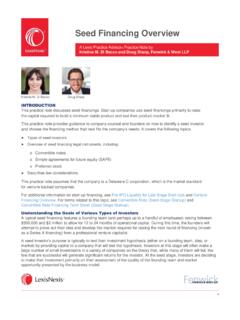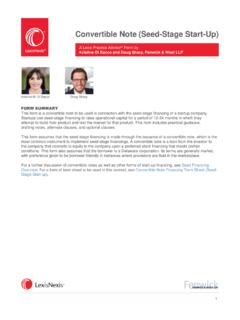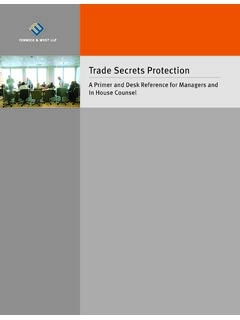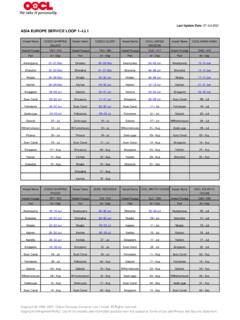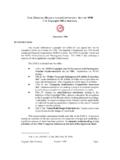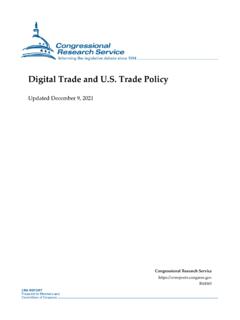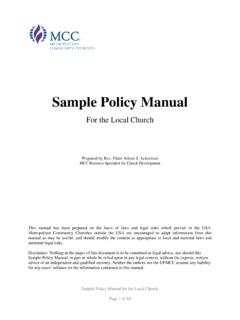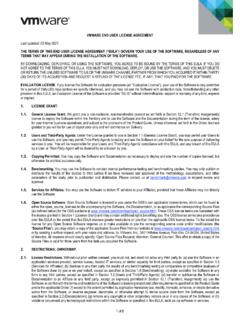Transcription of The Basics of Copyright Law
1 Copyright Basics 2006, 2015 Fenwick & West LLP. Some Rights Reserved. This work is licensed under a Creative Commons Attribution-NonCommercial-NoDerivs Unported article originally appeared in the California Bar Journal as an educational piece for attorneys not expert in intellectual property law, but is suitable for non-attorneys as have been helping a client set up her consulting business for failing bookstores (Speak Volumes Recovery Group), and she mentions that she has developed a PowerPoint presentation and hand-outs for use in their seminars. Do you think we should trademark or Copyright these materials? she asks. We re really jazzed about the slides; we made them much more exciting by using a lot of photos we found on the internet.
2 Also, the manuals we give our customers include some great ideas we ve developed about bookstore inventory control the Copyright will keep our competitors from using our ideas if we register the manual, right? Well, you respond, Let me think about that. (Maybe you should have taken that intellectual property course in law school after all!)No mind; not too late. Copyright issues can arise in any practice, but you don t need to become an expert in the most sophisticated and arcane aspects of the practice in order to answer some basic questions. This article seeks to provide you with just enough Copyright law to understand the fundamentals and address the key what is a Copyright ?
3 Copyright refers to the rights of authors in works of authorship as distinguished from patents (whose subject matter is inventions), trademarks (which concern symbols of an enterprise s reputation and goodwill) and trade secrets (information whose value derives from being kept secret). Copyright protects the expression in a work of authorship against copying. Copyright law does not protect the underlying ideas embodied in a work; neither does it protect against independent Copyright protection is automatic, essentially free, and more or less world-wide in scope. Although people often speak of copyrighting a work or obtaining a Copyright , these are misnomers.
4 The copyrights in any original work of authorship come into existence automatically, without further action, as of the moment of fixation of the work. Registering a work with the Copyright Office and marking a work with a Copyright notice are not required, and failure to do so does not result in loss of the basic rights of Copyright requirementsThere are three basic requirements for Copyright protection: that which is to be protected must be a work of authorship; it must be original; and it must be fixed in a tangible medium of The Work of Authorship RequirementWhat is a work of authorship? The subject matter of Copyright embraces a wide range of works, whether published or unpublished, including: Literary or textual works of all kinds (including novels, short stories, biographies, articles, news stories, poems, outlines, letters, email messages, etc.)
5 Pictorial, graphic and sculptural works (including sketches, paintings, photographs, drawings, designs, etc.). Musical, dramatic and choreographed works (songs, telephone ring tones, plays, TV shows). Sounds recordings (performances of songs, public speeches, books on tape).The Basics of Copyright LawJust Enough Copyright for People Who Are Not Attorneys or Intellectual Property Expertsby mitchell zimmerman 2 Copyright Basics fenwick & west llp Computer programs, most websites, and various other digitized The Originality Requirement Originality is a constitutional requirement, but it is a minimal requirement under Copyright , not comparable to the nonobviousness standard for a patent.
6 A hackneyed or trivial work can be original enough for Copyright protection, so long as it is not copied from an earlier work and so long as it contains a tiny spark of creativity. What would represent insufficient creativity? Arranging the names in a telephone directory in alphabetical The Fixation RequirementA work must be fixed, under Copyright law, to enjoy Copyright protection. This does not mean it must be the final or a well-considered version of the work. Rather, the term simply refers to the requirement that an embodiment of the work be set down or fixed in a tangible medium of expression for a more than transitory period. A draft of a novel on paper, the rushes from a film before editing, the beta version of a computer program on a CD-ROM disk, a snapshot on film or a digital camera s flash memory, all are fixed works within the meaning of Copyright law.
7 But the most brilliant and creative improvisation is not fixed if unscripted and of registration with the Copyright officeRegistration, though not required for basic Copyright protection, has important advantages: Registration is necessary if you want to (i) record security interests in a Copyright , (ii) ask Customs to block infringing goods from being imported into the country, (iii) benefit from the (rebuttable) presumption that all facts stated in the registration certificate, including ownership, are true or (iv) be eligible for statutory damages and attorneys cases in which the infringement begins after registration or within three months of publication, the registrant is entitled to statutory damages damages awarded without need of evidence of harm to the plaintiff or unjust enrichment of the defendant in a discretionary amount between $750 and $30,000 per infringed work (increased to as much as $150,000 per infringed work in cases of willful infringement ).
8 The plaintiff is in any event always eligible for actual damages or infringer s profits if they can be is also required (v) as a condition for filing a Copyright infringement lawsuit. The registration is just the ticket for getting into court, however; you can register and sue even if you had not registered before you learned of the infringement . Also, it is not uncommon for plaintiffs to file a complaint and attach a registration application, and then to substitute the actual registration certificate form is a simple one and the registration fee, relatively trivial. Some works, like computer software and web sites, can pose more difficult issues, and a lawyer s help may be needed for them.
9 The Copyright Office s examination of the application is largely ministerial, and it does not engage in the kind of substantive review characteristic of patent and trademark a copy versus owning a copyrightAlthough a work must be fixed in order to be protected, the Copyright in a work is not the same as the physical medium in which the work was fixed. It follows that owning a copy of a work (even, for example, the original of a painting) is not the same thing as owning the copyrights in the work. The owner of a lawfully transferred copy (or original) therefore does not own the copyrights, in the absence of an express Copyright assignment in rights of Copyright holders and limiting doctrinesUnder the Copyright Act of 1976 (and international Copyright law), the Copyright holder owns a bundle of rights.
10 The Copyright owner is the only one who has the right to reproduce the work in copies; prepare derivative works based on the original work; 3 Copyright Basics fenwick & west llp distribute copies to the public; or display and perform the work the Copyright holder owns these exclusive rights with respect to a work, there are still limits on the scope of the rights. These are the principal limiting doctrines: Copyright does not protect against independent development, only against copying. Thus, if you and I each independently write identical sonnets, without any copying, each of us owns a Copyright in our own work notwithstanding who came first or that the works are the same.
